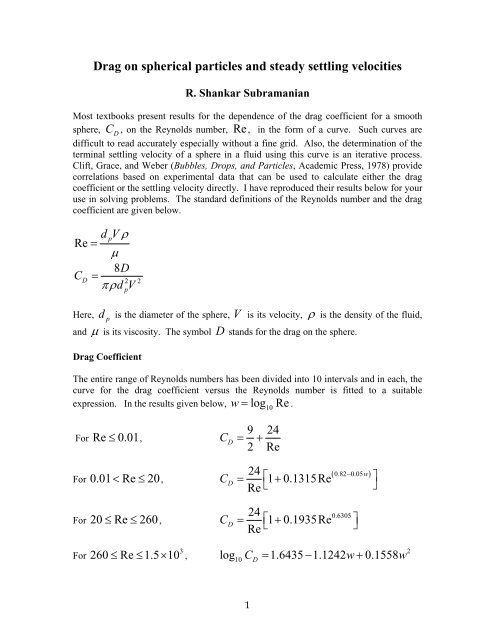Drag on a Sphere
Drag on a Sphere
Drag on a Sphere
Create successful ePaper yourself
Turn your PDF publications into a flip-book with our unique Google optimized e-Paper software.
<str<strong>on</strong>g>Drag</str<strong>on</strong>g> <strong>on</strong> spherical particles and steady settling velocitiesR. Shankar SubramanianMost textbooks present results for the dependence of the drag coefficient for a smoothsphere, CD, <strong>on</strong> the Reynolds number, Re, in the form of a curve. Such curves aredifficult to read accurately especially without a fine grid. Also, the determinati<strong>on</strong> of theterminal settling velocity of a sphere in a fluid using this curve is an iterative process.Clift, Grace, and Weber (Bubbles, Drops, and Particles, Academic Press, 1978) providecorrelati<strong>on</strong>s based <strong>on</strong> experimental data that can be used to calculate either the dragcoefficient or the settling velocity directly. I have reproduced their results below for youruse in solving problems. The standard definiti<strong>on</strong>s of the Reynolds number and the dragcoefficient are given below.dVρpRe =µ8DCD=πρdVHere,dp2 2pis the diameter of the sphere, V is its velocity,and µ is its viscosity. The symbol D stands for the drag <strong>on</strong> the sphere.<str<strong>on</strong>g>Drag</str<strong>on</strong>g> Coefficientρ is the density of the fluid,The entire range of Reynolds numbers has been divided into 10 intervals and in each, thecurve for the drag coefficient versus the Reynolds number is fitted to a suitableexpressi<strong>on</strong>. In the results given below, w = log10Re .For Re ≤ 0.01,9 24CD= +2 ReFor 0.01< Re ≤20,C D24 1 0.1315Re(0.82 0.05= ⎡ +Re ⎣− w)⎤⎦20 ≤Re ≤260For ,260 ≤Re ≤ 1.5×10For ,324 1 0.1935Re0.6305CD= ⎡ +⎤Re ⎣⎦log C = 1.6435 − 1.1242w+ 0.1558w10D21
1.5× 10 ≤Re ≤ 1.2×103 4For ,log C =− 2.4571+ 2.5558w− 0.9295w+ 0.1049w10D2 31.2× 10 ≤Re ≤ 4.4×104 4For ,log C =− 1.9181+ 0.6370w−0.0636w10D24.4× 10 ≤Re ≤ 3.38×104 5For ,5 5× ≤ ≤ × CD= 29.78 − 5.33.38 10 Re 4 10For ,5 6× ≤ ≤ CD= 0.1w−0.494 10 Re 10For ,log C =− 4.3390 + 1.5809w−0.1546w10Dw2610 < ReFor ,C D8×10= 0.19 −Re4You can use the above equati<strong>on</strong>s to evaluate the drag coefficient when needed.Terminal Settling VelocityIf you want to calculate the terminal settling velocity of a sphere, you will find that thisvelocity appears in both the drag coefficient and in the Reynolds number. Therefore, youmust perform an iterative calculati<strong>on</strong> to find the answer. To avoid doing this, Clift,Grace, and Weber also provide results that permit the direct calculati<strong>on</strong> of the terminalsettling velocity. Recall that for terminal settling, the drag <strong>on</strong> the sphere is equal to itsnet weight, which is the weight minus the buoyant force <strong>on</strong> the sphere. We define theReynolds number in the same way as before, but with the understanding that it nowV = V terminalapplies with . A new dimensi<strong>on</strong>less groupD Dis introducedin which the terminal settling velocity does not appear. Therefore you can calculate thisgroup and use the equati<strong>on</strong>s given below to calculate the value of the Reynolds numbercorresp<strong>on</strong>ding to a given value of ND. From the Reynolds number, you canimmediately evaluate the terminal settling velocity. In the equati<strong>on</strong>s, W = log10ND.N= CRe2N ≤73; Re ≤2.37For ,DNDRe = − 1.7569× 10 N + 6.9252× 10 N − 2.3027× 10 N24−4 2 −7 3 −10 4D D D2
















